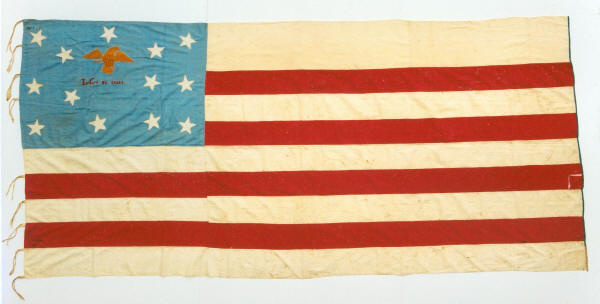
| |
Exceptional 13 Star Flag -- 1857 -- Eagle in Canton -- In God We Trust |
|
| Available: |
Sold |
| Frame Size (H x L): |
|
| Flag Size (H x L): |
49" x 109.5" (4'1" x 9'2") |
|
| Description....: |
|
| This is one of the most rare and beautiful, pre-Civil War, 13 star flags that I have ever come in contact with. On a canton of cornflower blue cotton chintz, 13 randomly placed stars surround a cheddar yellow cotton appliqued eagle. Under this "In God We Trust" appears in needlework cross-stitch with red wool thread.
This finely hand-sewn, cotton example puts to rest the suspicions of some flag enthusiasts who have claimed that cotton flags were not made during or prior to the war between the states. Because I have owned many Civil War-era, hand-made cotton flags, I have never held this belief. In early America, unless people had extensive resources, they made do with what they had on hand. If they had cotton, they made a cotton flag. If they had wool, they made a wool flag. If they had a little of both but not enough of either one, they mixed fabrics. If they lacked time, they might paint the stars on one side and applique them on the other. There are exceptions, of course. Seafaring vessels almost exclusively used wool as the primary fabric because it sheds water. Flags made under military contract would be made to certain specification. But homemade flags and flags made in times of dire need were different. It could be very difficult, particularly in rural areas, to travel and obtain materials. At the same time, poverty forced ingenuity and necessity. If someone needed an American flag, they made it, so long as they could scrounge up fabric, thread, and a needle.
Still, I have not before held a cotton flag in my hands that I could positively date to a specific year before 1861. This one has a cross-stitch, needlework date in the upper left corner of the canton that reads "1857". The thread is black silk and it is very clearly contemporaneous with the making of the flag. The presence of the date therefore makes the flag unique among known examples.
Early American Stars and Stripes with eagles in their cantons are extremely rare, and this is especially true outside museums. Some Union, Civil War battle flags have painted eagles as the primary subject inside the star formation, but even these are very few in number. One other reason for American national colors with eagles are peace offerings from the Federal Government to Native American tribes. The eagle was chosen to accompany the stars on some flags given for this purpose because of its importance as a totem among most Indian nations. Known as Indian Peace flags, 5 or fewer of these are known to have survived. The most famous of these resides at the Smithsonian.
Another similar use of eagle flags was as presentation gifts to American Indians from Fur Traders wishing healthy relations and co-habitation of lands that provided good fur harvest. The Hudson Bay Company was known to have presented at least one of these flag of this type, although in this example the eagle was present in the stripe area instead of the canton. And some flags expected to be Indian Peace flags may instead have been used on riverboats along the Hudson in New York State. Such flags are seen in some paintings of Hudson River steamers during the mid-late 19th century and it is logical to assume that some of these flags were more than simply artist's license.
CHARACTER LIMIT EXCEEDED -- MORE INFORMATION TO FOLLOW SHORTLY |
|
|
|
| Collector Level: |
|
|
| Flag Type: |
Sewn flag |
|
| Star Count: |
13 |
|
| Earliest Date of Origin: |
1857 |
|
| Latest Date of Origin: |
1857 |
|
| State/Affiliation: |
13 Original Colonies |
|
| War Association: |
1777-1860 Pre-Civil War |
|
| Price: |
No |
|
| |
Views: 3653 |
|
|
|

